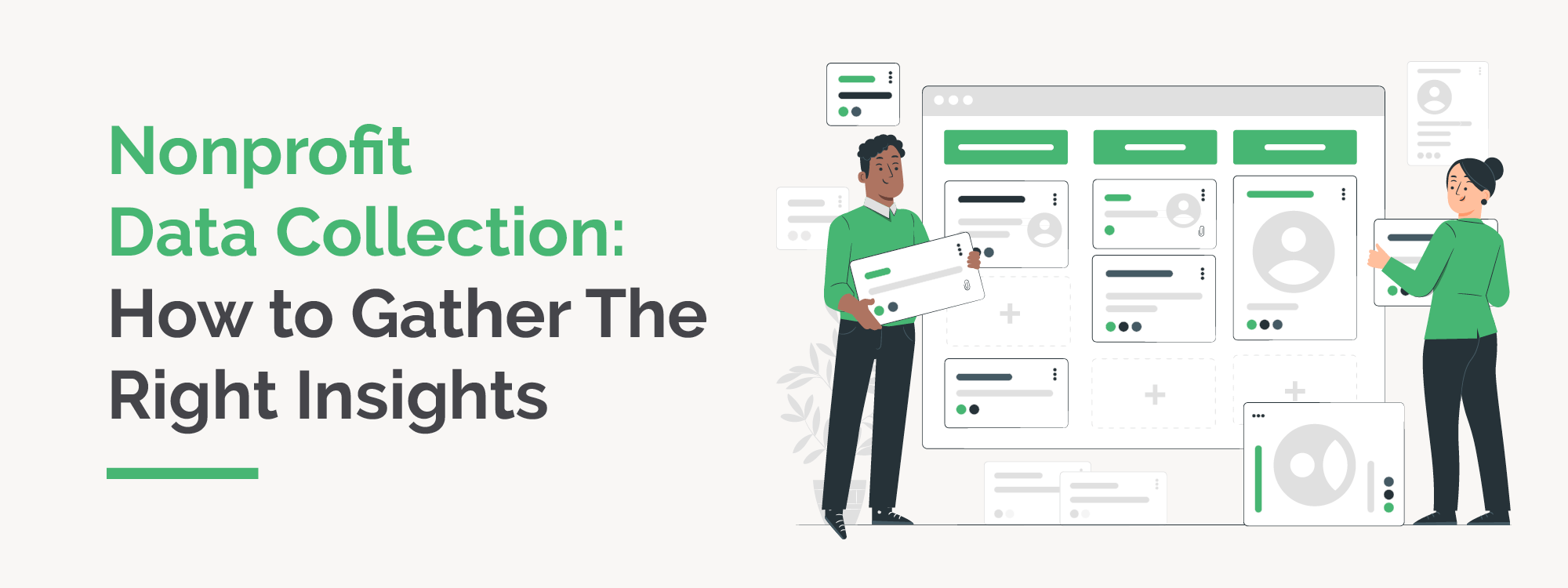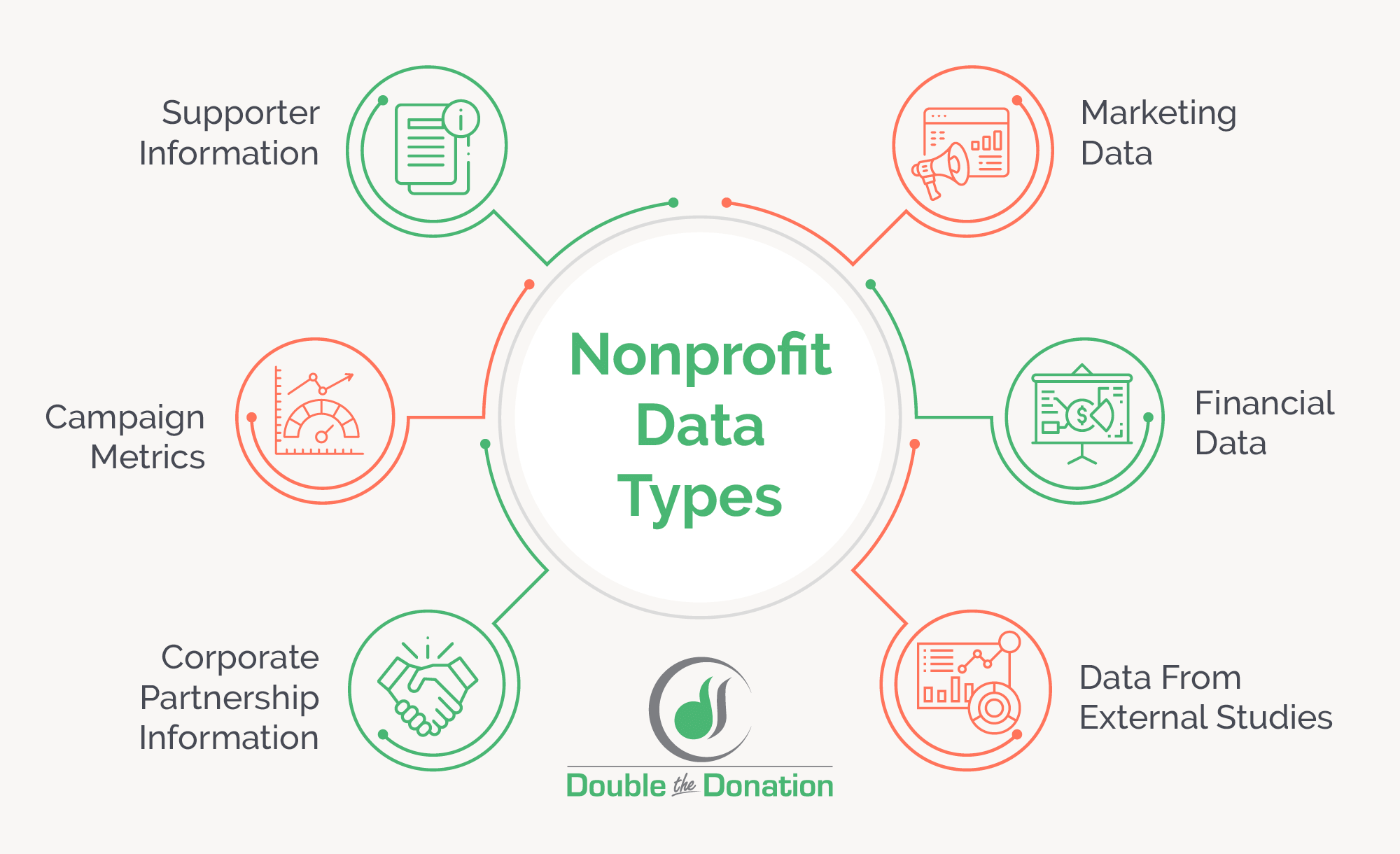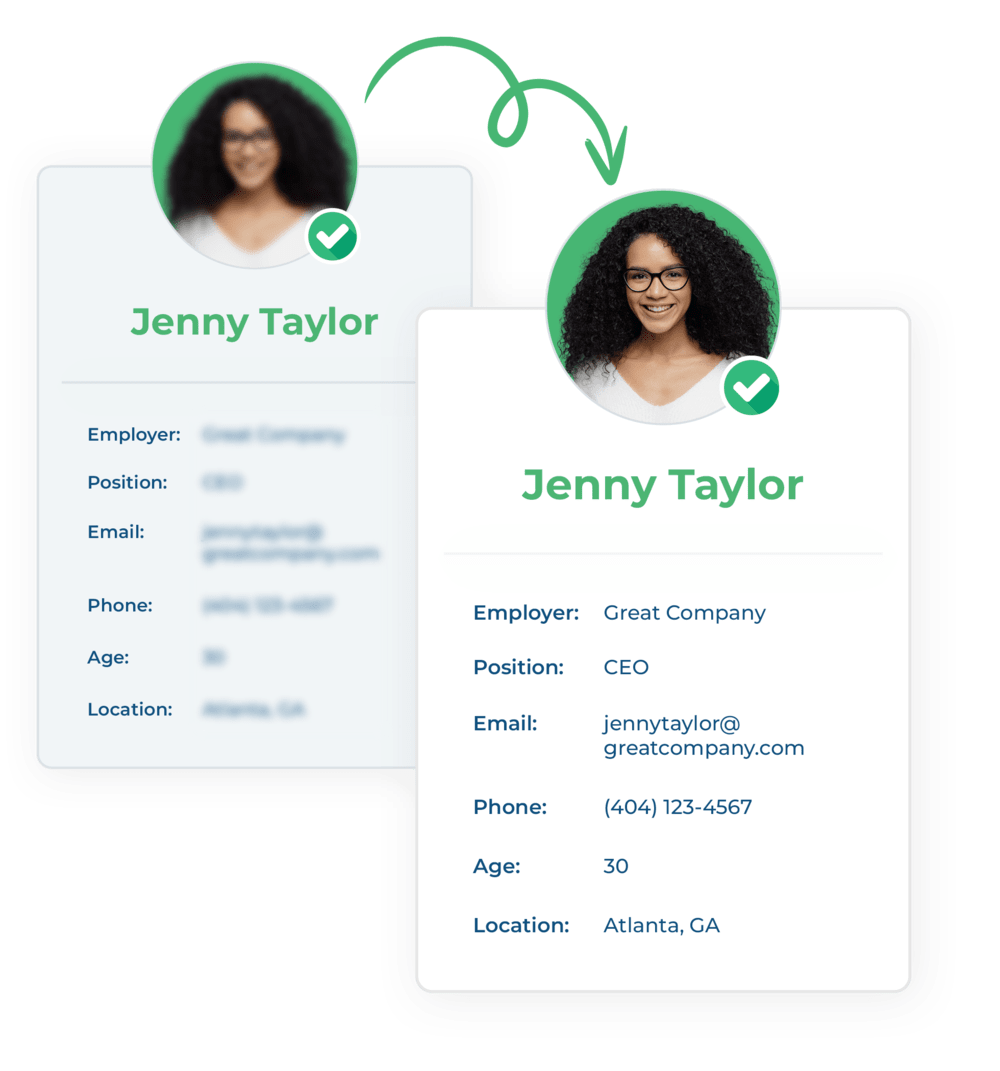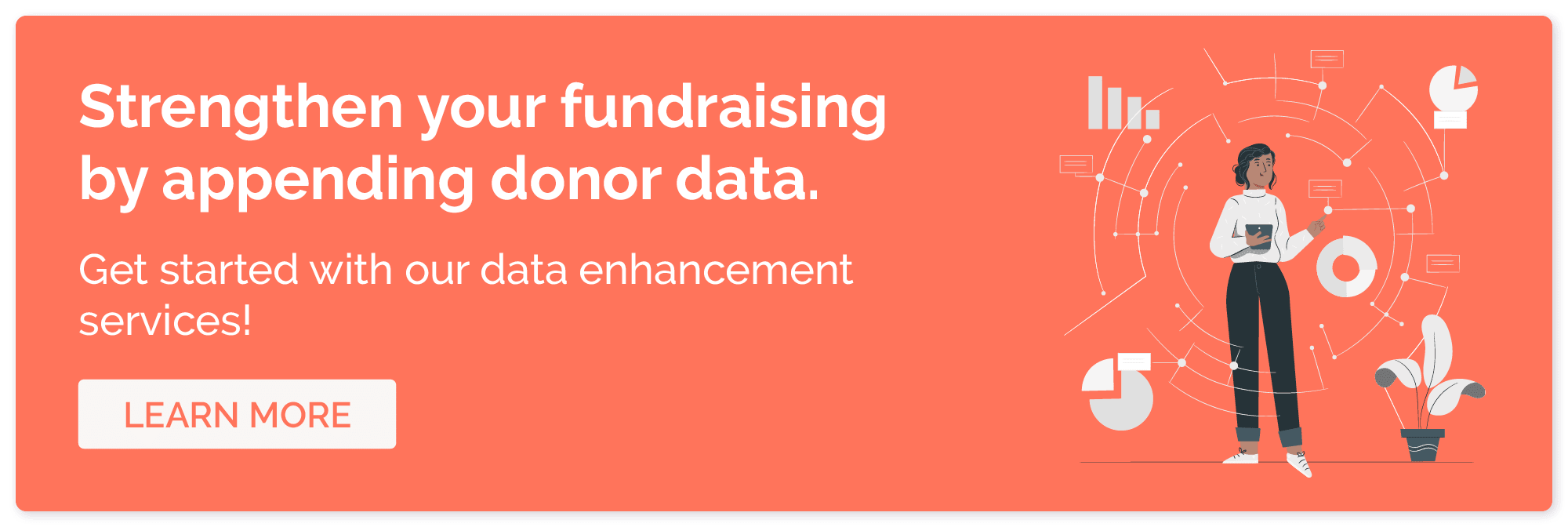Nonprofit Data Collection: How to Gather The Right Insights
From local communities to global movements, effective nonprofit data collection is a silent hero. Collecting nonprofit data involves systematically gathering, analyzing, and using information to track performance, enhance decision-making, and amplify impact. It’s not just about numbers; it’s about understanding your organization’s needs, measuring progress, and strategizing to meet local and global challenges.
Collecting the right data helps organizations like yours understand what works so you can do more good in the world. That way, you can use your resources more efficiently to reach the right supporters and beneficiaries.
In this ultimate guide, we’ll share how nonprofits can collect data effectively and explain how that data can serve as the fuel for transformative action. Here’s what we’ll cover:
- How Do Nonprofits Collect Data?
- The Importance of Efficient Nonprofit Data Collection
- Key Types of Nonprofit Data to Collect
- Tips to Improve Your Nonprofit Data Collection
With the right insights, your nonprofit can make a greater impact on the world, whether you’re focused on improving your corporate partnerships, marketing segmentation, finance management, or programs. Let’s dive in!
How Do Nonprofits Collect Data?
Nonprofits can collect data through various methods, depending on their goals, resources, and the nature of the data they need. Here are some common methods and types of data collection software for nonprofits:
- Forms: Your nonprofit can use donation forms, volunteer applications, event registrations, and intake forms to gather supporter and beneficiary information. Each form is designed to collect data about different types of recipients. For example, donation forms collect donor data like contact information, donation amount, payment information, employer information for matching purposes, and gift designations.
- Surveys and Questionnaires: Nonprofits can use surveys to gather feedback from beneficiaries, donors, and the general public. These questionnaires can be distributed online, via email, social media, or in person.
- Marketing Platforms: Nonprofits can view metrics within their digital marketing platforms to understand audience behaviors and tailor messaging. For example, Google Analytics provides information about website visitors, including how much time they spend on specific pages, what content they engage with, and what channels drive them to the site. Meanwhile, email marketing tools provide insights on open rates, click-through rates, and conversions which explain which content and calls to action resonate.
- Financial Management Software: Specialized software helps manage and report on financial data like revenue and expenses, ensuring compliance with accounting standards and regulatory requirements.
- CRM Systems: Customer Relationship Management (CRM) systems like Salesforce for Nonprofits, Bloomerang, and Blackbaud store all interactions with supporters and corporate partners, including communications, contact information, contributions, and feedback.
How you collect data depends on which metrics you want to focus on to ensure long-term sustainability and increase impact. Decide on which data will best support your organization and put systems in place to gather it.
Qualitative vs. Quantitative Nonprofit Data
There are two categories of nonprofit data you can collect:
- Quantitative data refers to information that can be quantified, meaning it can be measured and expressed numerically. Examples include the number of volunteers who participated in an event, the amount of money raised from a fundraiser, the number of website visits, and the number of acquired donors in a certain time frame.
- Qualitative data is descriptive data that cannot be assigned a numerical value. This includes information like donor names, anecdotal survey responses, and preferred contact methods.
By leveraging both types of data, nonprofits can gain a more comprehensive understanding of their impact, tailor their services more effectively, and better communicate their successes and challenges to stakeholders.
The Importance of Efficient Nonprofit Data Collection
Nonprofits are expected to compete for time, attention, and money with companies and peer organizations. In fact, the average person sees roughly 5,000 ads per day. Standing out requires speaking to the right people at the right time with the right message. Nonprofit data makes that possible!
Here’s a rundown of the most important benefits of nonprofit data:
- Measure impact and see which programs are working
- Better understand how to effectively allocate resources (e.g., time, money, and personnel)
- Make informed decisions, such as planning new programs based on community needs assessments
- Demonstrate accountability by sharing how funds are being used
- Deliver timely appeals based on past engagement data to inspire action, raise funds, and cultivate relationships
- Send powerful messages at the optimal time by segmenting communications based on interests and preferred communication channels
- Communicate program impact and challenges to stakeholders
For an example of nonprofit data in action, imagine an organization dedicated to providing clean water across continents. By collecting data on water quality, community health, and usage patterns, the nonprofit can tailor its initiatives to each region’s specific needs, ensuring that resources are used efficiently and that the solutions are sustainable.
By processing and analyzing data, nonprofits can create targeted interventions, monitor outcomes, and adapt strategies—activities that are crucial in a world where resources are limited and stakes are high.
Key Types of Nonprofit Data to Collect
There are endless types of nonprofit data you can collect, but some are much more helpful than others. For example, you don’t need to know which elements a user hovered over but didn’t click on your website. Unless this metric directly tied to improving user experience, collecting this nonprofit data will only bog down your software.
Let’s explore six types of nonprofit data you should collect.
Supporter Data
Data can tell you a lot about your donors, volunteers, and corporate sponsors. The more you know about your supporters, the better you can tailor your appeals to resonate with them.
Some of the most helpful supporter data to collect includes the following:
- Full name, including preferred name and title
- Geographic location to send relevant appeals, such as nearby events
- Date of birth so you can segment communications based on age and reach out on supporters’ birthdays
- Contact information, including email addresses, phone numbers, and postal mailing addresses
- Employment details to locate corporate giving opportunities and estimate giving potential
- Education, including areas of study to reveal causes they’re likely to support
- Giving history such as donation amounts, frequency, gift designations, attended events, and volunteer involvement
- Hobbies and interests to understand what opportunities inspire donors
- Charitable involvement with other organizations, such as board service or donations
Here’s a sample donor profile to give you an idea of what this data might look like:
Sufficient nonprofit data collection practices will enable you to easily segment your supporters into groups to improve your outreach. The good news is that if some of this information is missing or outdated, data appending services can fill it in. We’ll explore this type of nonprofit data collection service later.
Marketing Data
You know who your supporters are, but do you know how to communicate with them? Collecting marketing data will help you understand what messages resonate and encourage your audience to get involved.
Key marketing data to collect includes:
- Website traffic: Pay attention to how many people visit your site, how they get there, what pages they visit, and how long they stay. This information will help you optimize the user experience and set your website up to convert.
- Social media engagement: Impressions, likes, shares, and comments tell you whether your social media posts are reaching your audience and encouraging engagement.
- Email open and click rates: Are your subscribers opening your emails and clicking through to your site? These metrics let you know how effective your email marketing is. If your open rates are low, experiment with your subject lines and send emails under a real person’s name, like your fundraising director.
- Advertising data: If your nonprofit advertises, look at keyword volume and competition. Getting Attention recommends choosing keywords with high search volume and low competition. For your ads themselves, nonprofit data like impressions, ad conversions, click-through rate (CTR), and cost per click (CPC) tell you how well your ads are performing and how much they’re costing you.
To collect this nonprofit data, audit your past marketing efforts and review what information your marketing software automatically collects. In turn, you can learn which platforms and messages drive supporter engagement to set future outreach up for success.
Campaign Data
Collecting campaign data will help evaluate your nonprofit’s effectiveness and better plan campaigns in the future. Important nonprofit campaign data to collect includes:
- Donor and volunteer retention rates: Track how many donors or volunteers continue engaging with your organization over time. A donor or volunteer is considered “lapsed” if they haven’t given or volunteered within the past 12 months, but the length of time is up to your organization. High retention rates often indicate strong relationships and effective engagement strategies. Compare your nonprofit data with industry data to gauge success. For instance, Fundraising Report Card’s donor research indicates that the average donor retention rate is approximately 35%.
- Event attendance: Measuring attendance at events helps your nonprofit gauge interest and engagement levels and assess the effectiveness of promotion strategies.
- Campaign conversions: Monitor data on how many people took the desired action as a result of a campaign, such as donating, signing up to volunteer, or registering for an event. Also, pay attention to how many people your campaign converts into first-time supporters vs. recurring supporters.
- Fundraising totals: Track the total funds raised per campaign to assess financial success and allocate your budget to future campaigns.
By systematically collecting campaign data, you can continuously improve your campaigns and invest in the most successful campaigns.
Financial Data
Nonprofits often operate on tight budgets, so keep a close eye on your finances by tracking:
- Expenses: Monitor costs associated with delivering programs and running fundraising campaigns. Also, use your financial data collection software to monitor operational and capital costs like salaries, rent, utilities, major equipment, and buildings.
- Revenue: Track your income via donations, grants, event fees, product sales, membership sales, and other revenue sources.
- Cash-on-hand: This is the total amount of accessible money at any given time from checking accounts or on-premise cash reserves that aren’t reserved or invested. This data indicates how long your nonprofit can survive without donations or funding.
Tracking this information will ensure your nonprofit’s financial health, help meet regulatory requirements, make informed management decisions, and maintain the trust of donors, volunteers, and other key stakeholders.
Corporate Partnership Data
Strong corporate partnerships help expand your nonprofit’s initiatives. Considering these relationships need to be mutually beneficial, you should track data related to your partnerships, such as:
- Key contacts: Track the names, positions, and contact details of the primary contacts at the company.
- Agreement terms and duration: Monitor the specific terms of the partnership agreements like the objectives and responsibilities of each party so you can fulfill all obligations. Also, know the start and end dates of the agreement.
- Renewal conditions: Ensure you know the criteria your nonprofit must meet to have the partnership renewed at the end of the contract’s term.
- Financial contributions: Track donation amounts, dates, and in-kind contributions such as goods, services, or expertise provided by the partner.
- Employee engagement: Monitor corporate employees’ involvement in your nonprofit’s activities, including volunteer hours, participation in events, or matching donations.
- Impact metrics: Collect and share quantitative and qualitative data demonstrating the impact of the partnership on your nonprofit’s goals.
By collecting the right nonprofit data for your partnerships, you can maximize companies’ impact and demonstrate the value of these partnerships to your corporate sponsors. This data-driven approach not only helps maintain current partnerships but also attracts new corporate sponsors by showcasing the tangible benefits of collaborating.
Data From External Studies
Your nonprofit can better understand the market and improve its programs by leveraging data from external studies. Consider collecting data from the following sources:
- Public records: Collect demographic, economic, health, and educational statistics from public records to tailor services and understand the needs of your community. For example, a childhood education organization might collect demographic data from the U.S. Census Bureau to identify low-income areas with limited educational resources.
- Privately funded surveys: Incorporate data from market surveys, impact assessments, and stakeholder surveys to inform marketing strategies, evaluate program effectiveness, and gather feedback from key constituents.
- Research publications: Use academic research, industry reports, and policy analysis to gain evidence-based insights, understand industry trends, and navigate the regulatory landscape effectively. For instance, a health-focused nonprofit can use academic research from a university study that identifies effective strategies for reducing diabetes.
- Sector benchmarks: Use benchmarks to evaluate your organization’s performance related to peers. For instance, an animal welfare nonprofit might review annual benchmarking reports from a national animal protection agency to compare their animal adoption rates, recovery rates from medical treatment, and rehoming success with similar organizations.
Collecting data from external sources can cut down on the amount you spend conducting research. Just make sure you entrust reliable sources.
Tips to Improve Your Nonprofit Data Collection
Building an efficient nonprofit data collection strategy can be a large undertaking, but it will ultimately drive greater success for your organization. Here are some industry best practices to collect data ethically and efficiently.
Use Software That Integrates.
Chances are, your nonprofit uses software to run fundraisers, collect donations, manage volunteers, hold events, and oversee every aspect of your organization. In terms of nonprofit data collection, choosing systems that integrate can reduce the time and effort required to manage data across different platforms.
Integrated software ensures that nonprofit data is consistent and accurate, which minimizes errors that occur when manually transferring information between systems. Plus, it enables real-time data updates, giving all team members access to the latest information to make decisions.
For example, our matching gift software integrates with 100+ leading nonprofit software platforms, including fundraising tools, workplace giving platforms, CRMs, and more. That helps minimize nonprofit data inconsistencies from manual data entry, guaranteeing that donor information and matching gift opportunities are current and accurate across all systems.
Leverage Nonprofit Data Appending Services.
Nonprofit data appending is a process where additional data elements are added to your database to enrich the information you have on donors, volunteers, and other contacts. The process involves comparing the data you provide to a larger, external database and integrating new information to create more complete constituent profiles.
Our nonprofit data appending guide explains that you can append all sorts of information, such as:
- Contact details like phone numbers, email addresses, postal addresses, and social profiles
- Employment data like job title and employer’s name
- Demographics like net worth, birthdate, gender, and political affiliation
Routinely leveraging data enhancement services ensures you have accurate, complete information to understand your supporters, can contact them without messages bouncing, and can better drive them to give.
Use Ethical Nonprofit Data Collection Practices.
When it comes to nonprofit data collection, you should always respect the rights and privacy of your supporters. Here’s how you can accomplish that:
- Obtain explicit consent from individuals before collecting their data. This involves explaining why their data is being collected and how it will be used.
- Leverage secure databases and software that enable encryption.
- Collect only necessary data and avoid gathering irrelevant sensitive information.
- Give participants the right to access their own data, request corrections to inaccurate data, and opt out of your nonprofit data collection processes.
- Follow nonprofit regulations regarding data protection and privacy.
- Require employees to enable two-factor authentication, use a secure password management system, and routinely update passwords for your nonprofit’s software.
- Only give certain employees access to sensitive data.
Collecting data ethically will not only help you comply with legal standards, but it will also build trust among your supporters. Pay attention to standards and best practices specific to your industry. For example, nonprofits that handle protected health information (PHI) in the United States must adhere to the Health Insurance Portability and Accountability Act (HIPAA).
Routinely Clean Your Data.
As part of managing your nonprofit data, you’ll want to keep it clean. “Clean” data refers to data that’s not excessive, erroneous, inaccurate, outdated, mislabeled, or duplicated. The cleansing process helps maintain data hygiene and should be performed regularly, such as annually or bi-annually.
Some data collection software for nonprofits offers features like deduplication to make this process a breeze. Plus, data enhancement is always an option for updating or filling in missing information.
Imagine a nonprofit that continues to use community demographic data from ten years ago to design its youth education programs. Because the demographic profile (such as age distribution, income levels, and educational attainment) of the community can significantly change over the decade, relying on this outdated information could lead the nonprofit to offer programs that are no longer relevant or effective for the community’s current needs.
Next Steps for Your Nonprofit Data Collection
Ultimately, your nonprofit’s strength lies in its ability to make informed decisions that drive its mission forward. Effective data collection is the foundation of this strength, providing the insights needed to optimize resources, engage stakeholders, and measure the true impact of your work. As the sector continues to evolve, the organizations that prioritize data-driven decision-making will be the ones leading the charge toward a brighter future.
While you refine your nonprofit data collection processes, explore these resources to learn more:
- Improving Your Donor Development Approach: Expert Tactics. Developing donor relationships hinges on your nonprofit data. Make sure you’re leveraging your data to grow supporter relationships.
- Data Ethics and Privacy: Questions in Matching Gift Fundraising. Protecting donor data is essential for building trust and growing fundraising revenue. Follow the tips in this guide to ethically collect and protect data during the matching gift process.
- Prospect Research: The Ultimate Guide for Nonprofits. Explore what types of data to collect during prospect research and how to use this information to find new supporters.








